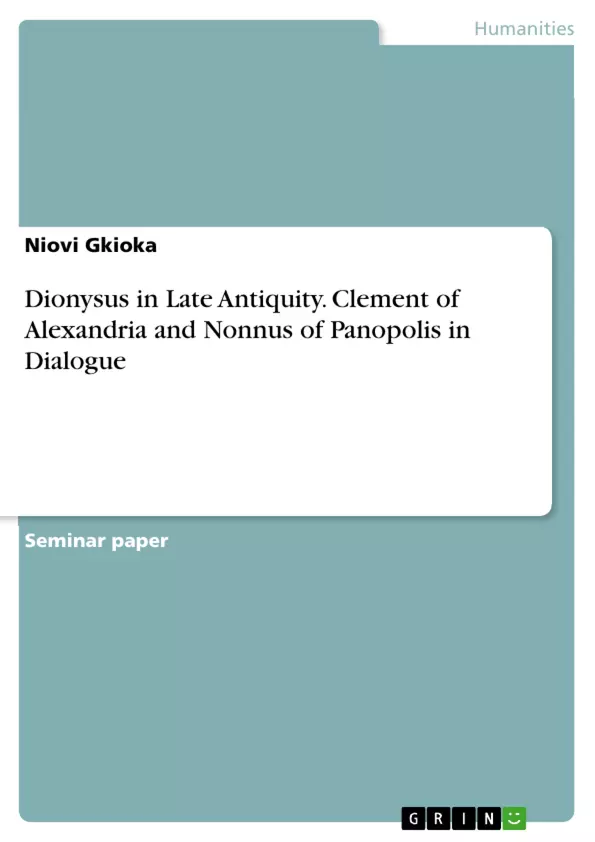The early Christian writers, in constructing a worldview in continuation with the Old Testament, were inevitably faced with the challenge of the widespread Greek culture, and in particular of the Greek religion. Specifically, of all the Greek gods, the most vexing seems to have been Dionysus, who in striking parallel with Christ is a resurrected god – according to the Zagreus mythic tradition – has universal aspirations for his cult, was the offspring of a mortal mother and a god, performs miracles, and not least, has wine as a sacred element in his ritual observances. These analogies between Dionysus and Christ, which make their thematic comparison fitting, were first exploited by Paul in ca. 54 CE. In his epistles to Corinthians his language reflects Dionysian cults in places (1 Cor 12:2) and notably, the consumption of wine in private meetings is rendered in distinctively Dionysian phraseology (1 Cor 11:17-34).
Similarly, as Richard Seaford has asserted, weighing in on the long-standing debate of the similarities between the Acts and the “Bacchae” first documented by Wilhelm Nestle in his 1900 article ‘Anklänge an Euripides in der Apostelgeschichte,’ the Acts and the Bacchae feature too many affinities, and at key points – Paul’s conversion (Acts 9:3-7; 22:6-11; 26:12-18) and Paul and Silas’ prison escape (Acts 16:19-40) – to be taken as mere coincidence.
These very parallels between Dionysus and Christ were drawn more distinctively in the second and third century CE by Greek and Latin Apologists; that is Christian intellectuals who writing in defence of Christianity assumed a polemic stance against Dionysus.
Inhaltsverzeichnis (Table of Contents)
- INTRODUCTION
- CLEMENT-IMITATIO DIABOLICA-
- NONNUS OF PANOPOLIS: 'THE INCERTUS'..
- CONCLUSION
Zielsetzung und Themenschwerpunkte (Objectives and Key Themes)
This text aims to analyze the complex relationship between Dionysus and Christianity in Late Antiquity, focusing on the works of Clement of Alexandria and Nonnus of Panopolis. The study explores how these authors, writing in different contexts, engaged with the figure of Dionysus and his cult, and how their works reflect the broader cultural and religious landscape of the time.
- The appropriation and repudiation of Dionysian imagery by early Christian writers
- The intersection of Dionysian and Christian motifs in Nonnus' works
- The assimilation of Dionysus with Christ in Late Antiquity
- The role of syncretism and monotheism in the evolution of religious thought
- The impact of Greek culture on the development of early Christianity
Zusammenfassung der Kapitel (Chapter Summaries)
- INTRODUCTION: This chapter sets the stage for the study, outlining the historical and cultural context in which early Christians confronted the figure of Dionysus. It highlights the striking parallels between Dionysus and Christ, drawing on examples from Paul's epistles and the Acts of the Apostles.
- CLEMENT-IMITATIO DIABOLICA-: This chapter focuses on Clement of Alexandria, a prominent Church Father who engaged with the figure of Dionysus in his work. It examines his use of "imitatio diabolica," a strategy of both appropriating and repudiating Dionysian imagery to discredit paganism and promote Christianity.
Schlüsselwörter (Keywords)
This text delves into the interconnectedness of Dionysus and Christianity in Late Antiquity. It focuses on the works of Clement of Alexandria, Nonnus of Panopolis, and their engagement with Dionysian imagery and themes. Key terms include: Dionysian cults, Christian apologetics, imitatio diabolica, syncretism, monotheism, Greek culture, late antiquity, omophagia, bacchic imagery.
- Citation du texte
- Niovi Gkioka (Auteur), 2015, Dionysus in Late Antiquity. Clement of Alexandria and Nonnus of Panopolis in Dialogue, Munich, GRIN Verlag, https://www.grin.com/document/317267



